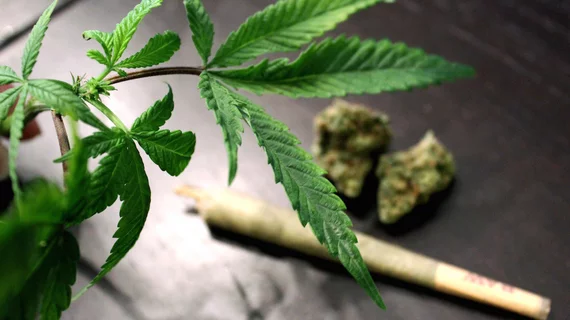Young marijuana users face increased risk of stroke
Young people who use cannabis—especially if they’re frequent users—could face an up to threefold increased risk of stroke compared to their peers, researchers have found.
A study authored by Tarang Parekh, MBBS, MSc, and colleagues and published Nov. 5 in Stroke analyzed nearly 44,000 adults between the ages of 18 and 44, considering people’s marijuana use in the context of health outcomes like hypertension, hyperlipidemia, diabetes and stroke. The authors said tetrahydrocannabinol (THC), the primary psychoactive agent in cannabis, is believed to have a dose-dependent effect on CV and cerebrovascular health through its direct interactions with cannabinoid receptors.
“The legalization and decriminalization of marijuana use in the United States and the rising popularity of its use among young adults culminate the need to understand the benefits and risks of using marijuana at a younger age,” Parekh, of George Mason University, and co-authors wrote. “Despite the fact that marijuana is the most widely used illicit drug with fewer adverse effects, recent evidence has suggested an association of marijuana use with cardiovascular and cerebrovascular events.”
Using pooled 2016-2017 data from the Behavioral Risk Factor Surveillance System, a nationally representative cross-sectional survey run by the CDC, Parekh et al. evaluated a cohort of 43,860 adults, around half of whom were women. Overall, 13.6% of the group reported using marijuana within the past month, with 63.3% of them being men.
Compared with non-users, users of cannabis were on average younger; 73.8% of users fell between the ages of 18 and 34, while just 61% of non-users were in that age bracket. Users were also more likely to:
- Be non-Hispanic white or black
- Have some college education
- Be physically active (81.8% vs. 77.5% of non-users)
- Be heavy drinkers (16.8% vs. 4.9%)
- Use combustible cigarettes (37.9% vs. 15%)
- Use e-cigarettes (15.5% vs. 4.9%)
Despite the fact that marijuana users more often engaged in unhealthy behaviors like heavy drinking and smoking tobacco, rates of diabetes, hypertension and hypercholesterolemia were lower in the population, Parekh and colleagues said. Still, young adults with recent reported marijuana use saw a 1.82-fold increased risk of stroke compared to their counterparts.
Risk of stroke increased by a greater margin—2.45 times—if the individual was using marijauna frequently, at least 10 days a month. Compared with non-users, stroke odds were also higher among frequent cannabis users who also smoked combustible cigarettes (3.12-fold increased risk) or e-cigarettes (2.63-fold increased risk).
“Our post-stratified results showed greater odds of stroke in frequent marijuana use with current combustible cigarette and e-cigarette use,” the authors wrote. “Earlier studies were based on hospital discharge records or inclusive of men-only participants, whereas our study presented findings from a recent national survey with larger sample size and sampling weights that allow us to approximate the young marijuana users on a national level.”
Of course, using survey data means the team’s results are subject to self-reporting bias, Parekh and co-authors said. There’s also likely modulation in the strength and type of marijuana people were using, as well as genetic susceptibilities and social desirability biases that weren’t accounted for.
“Given the popularity of marijuana use in young adults, strategies to bring issues to light about potential cerebrovascular effects of marijuana and preventive strides to educate the youth for the same are warranted,” the researchers wrote.

